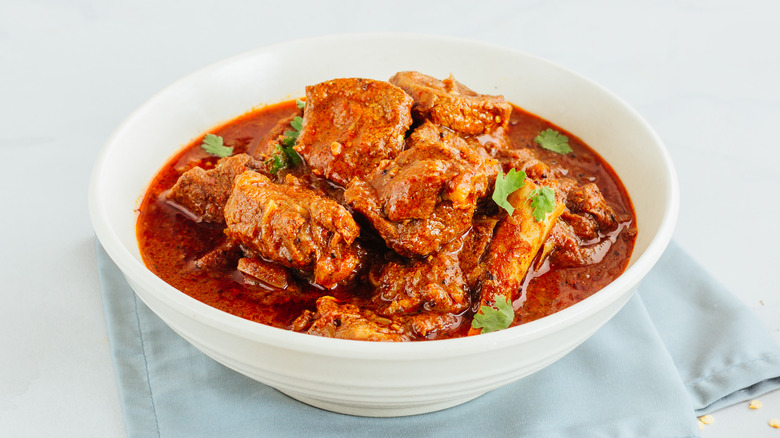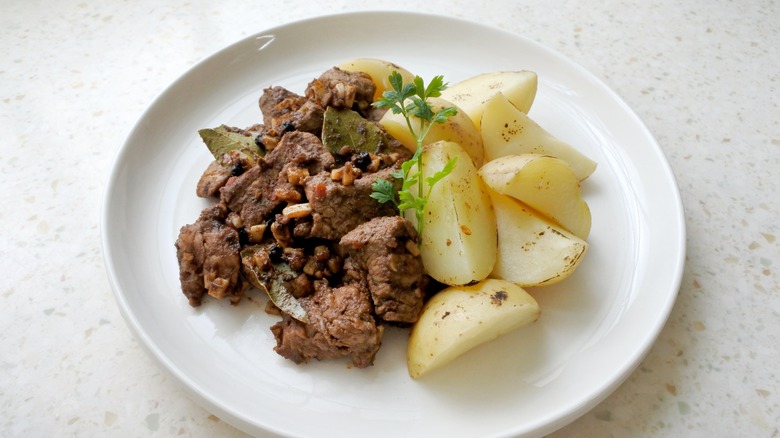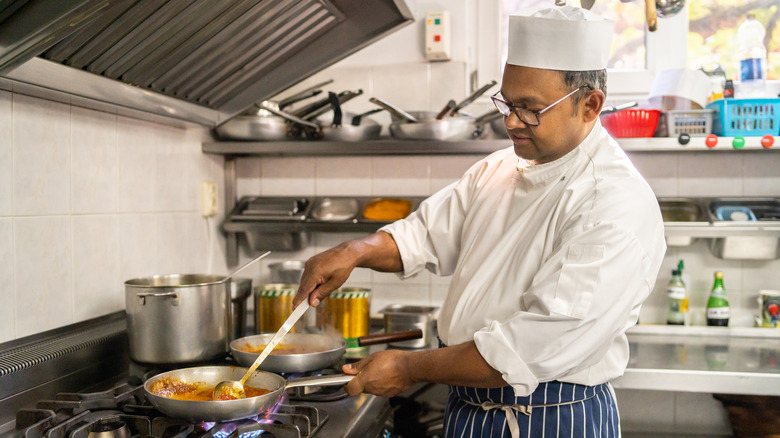The Complex Origins Of Vindaloo
Vindaloo is usually described as a spiced and spicy Indian curry, but that's misleading and undersells the complexity of this dish's origins. For a start, the term "curry" is pretty broad. It's probably derived from the Tamil word "kari", but they're not the same thing: Kari refers to a specific dish. As the term hopped languages, the meaning broadened to signify almost any dish with a spiced sauce. The origins of vindaloo tell a similar story of cultures blending and borrowing to create culinary history.
While it's true that vindaloo originated on the West coast of India in Goa, it takes substantial influence from a dish with a somewhat similar name, carne de vinha d'alhos, which originated on the Portuguese islands of Madeira and the Azores. Translating as "meat marinated with wine and garlic," true to its name, carne de vinha d'alhos is a meat stew with wine and garlic at the heart of it. It's still eaten in Portugal today but has been a popular dish throughout Portugal's history of colonization and migration, perhaps partly because the dish's preparation helps not just to improve the meat's flavor but also to preserve it. As a result, culinary descendants of this dish exist everywhere the Portuguese have gone, including Trinidad and Tobago, Hawaii, and Guyana. Often, these descendants are new dishes entirely, with indigenous peoples adapting the basic idea of the Portuguese dish with local ingredients, techniques, and flavors to make it their own. Goan vindaloo is one of these descendants.
From vinha d'alhos to vindaloo: What changed?
Vindaloo is similar in several ways to vinha d'alhos, enough so that in Goa, vindaloo can also be spelled vindalho, showing the close connection between the two dishes. Both use garlic and paprika, and both primarily use pork for the meat, although plenty of vindaloo variations exist, including fish vindaloo. However, some key differences exist in the ingredients used in each recipe. Where vinha d'alhos uses wine, vindaloo uses vinegar. One interesting theory about how this came about claims that when the Portuguese colonized India in the early 16th century, they brought wine with them, but this had turned to vinegar after the long journey around Africa to reach Goan shores. However, another theory is that as there was no wine in India when the Portuguese arrived, palm vinegar was used as an alternative in the recipe, and it stuck. Either way, vinegar is a vital element of a Goan vindaloo.
Whether or not a vindaloo should include potatoes has been much debated. Its culinary precursor in Portugal is sometimes served with potatoes, but not always. It's tempting to believe the theory that potatoes came to be included in vindaloos because the 'alhos' part of vinha d'alhos sounds passingly similar to 'aloo', which means potato in Hindi. However, Indian cuisine isn't defined by standardized recipes, and there are Indian cookbooks that have vindaloo recipes both with and without potatoes. There's no single authentic recipe for vindaloo, potato, or no potato.
The third vindaloo: British Indian Vindaloo
Food never stops evolving, and the vindaloo is no exception. Outside of India, the first thing many people think of when they hear vindaloo is mouth-numbing spiciness. A typical Goan vindaloo has some heat, but it shouldn't be overwhelming. Chilis were brought from the Americas to Europe by Columbus, and the Portuguese introduced chilis to India, who incorporated them into the vindaloo. However, the punishing spiciness that some associate with the vindaloo is thanks mostly to the British.
Curry, or more specifically British Indian curry, is a national obsession in the U.K. Chicken tikka masala is considered a U.K. national dish and the most popular when dining out. But the majority of curries served by the U.K.'s 12,000 curry houses are spicy, with British vindaloo famous for being a dish dominated by chili heat.
Fusion cuisine is tricky to define, partly because so many dishes — from the secret history of the California roll to the true origins of pasta – can be traced to two or more cultures. However, with Indian and Portuguese influence, British variants, and ingredients originating from around the world, the vindaloo seems to be a particularly rich example of fusion food. The evolution of vindaloo continues; today, you can even find lamb vindaloo at Trader Joe's. Frozen and microwaveable, it's far from authentic, but it shows just how much staying power the idea of a vindaloo has, even if what defines it is up for debate.


